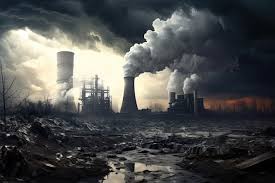Introduction
Global warming on Cooling Tower is increasingly affecting industries that rely on cooling towers to manage heat exchange processes. As temperatures rise and climate patterns shift, cooling towers are facing operational challenges that impact their efficiency, water consumption, and overall performance. The changing environment alters the way cooling towers dissipate heat, requiring industries to adapt by implementing new technologies and strategies. This introduction explores how global warming is reshaping cooling tower operations and what industries can expect in the coming years.
Reduced Cooling Efficiency: Cooling towers work by exchanging heat with the ambient air. As global temperatures rise, the temperature differential between the cooling water and ambient air decreases, making it harder for cooling towers to dissipate heat effectively. This leads to a drop in cooling efficiency, particularly during heatwaves, when systems are needed the most.
Increased Water Consumption: As temperatures rise, cooling towers require more water to achieve the same cooling effect. The higher evaporation rates result in greater water losses, putting additional strain on water resources, especially in regions already facing water scarcity. Industries may have to find alternative water sources or improve water management practices to meet these demands.
Higher Energy Consumption: With decreased cooling efficiency, cooling towers will need to operate for longer periods or at higher intensities to maintain required temperatures. This increased workload leads to higher energy consumption, driving up operational costs and increasing the carbon footprint of facilities.
Strain on Water Supply and Quality: The availability of water for cooling tower operations could become more limited as global warming exacerbates drought conditions in many regions. Additionally, higher temperatures can lead to warmer water sources, which further reduces cooling efficiency. Poor water quality, such as higher salinity or mineral content, can increase scaling and fouling, reducing system performance and requiring more frequent maintenance.
Increased Maintenance and Fouling: Higher temperatures promote the growth of algae and bacteria in cooling tower water, leading to biofouling. This buildup can decrease heat transfer efficiency and increase corrosion risks. More frequent cleaning and water treatment are required to prevent biofouling, adding to maintenance costs and operational downtime.
Potential for Higher Corrosion Rates: With the combined effects of increased water consumption, higher temperatures, and the presence of biofouling, corrosion rates in cooling tower systems may increase. Corrosion can lead to costly repairs, reduced equipment lifespan, and unexpected shutdowns.
Need for Upgraded Cooling Technology: As traditional cooling towers struggle with the effects of rising temperatures, industries may need to invest in upgraded cooling technologies. Solutions such as hybrid cooling towers, dry cooling systems, or advanced coatings may help offset the loss of efficiency and reduce the environmental impact of cooling tower operations.
Shift Towards Sustainable Solutions: With the growing impact of global warming, there’s an increasing need for sustainable water management solutions in cooling tower operations. This may include the use of recycled water, rainwater harvesting, or wastewater treatment systems to reduce reliance on freshwater sources, while also implementing energy-efficient cooling strategies.
Regulatory Pressures: As governments implement stricter environmental regulations to mitigate climate change, industries using cooling towers may face increased regulatory scrutiny. This could lead to the implementation of tighter controls on water usage, emissions, and operational efficiency, prompting companies to adopt more eco-friendly practices.
Seasonal Variability: Global warming is expected to increase the frequency of extreme weather events, including heatwaves and seasonal temperature fluctuations. This variability can make it more difficult for cooling towers to operate consistently, as cooling requirements may spike during hot summers and decrease during milder winters. Industries may need to adjust operational schedules or invest in flexible cooling systems to handle these seasonal shifts effectively.
Increased Risk of Thermal Pollution: As cooling towers release heated water back into natural water sources, global warming could exacerbate thermal pollution, where water temperatures rise to levels that harm aquatic ecosystems. Regulatory bodies may impose stricter limits on discharge temperatures, forcing industries to adopt cooling technologies that minimize environmental impact.
Greater Reliance on Backup Systems: As global warming affects cooling tower performance, industries may need to rely more on backup cooling systems to maintain operational stability during peak temperatures. Backup systems, such as air-cooled heat exchangers or hybrid cooling solutions, may become essential for preventing downtime during heatwaves.
Water Treatment Challenges: Higher temperatures not only increase biofouling but also make water chemistry more difficult to manage. In warmer climates, dissolved solids in water may increase, leading to scaling and deposition issues. Advanced water treatment solutions and the use of anti-scaling agents will be critical to maintaining efficient cooling tower operations.
Increased Infrastructure Costs: To cope with the effects of global warming, industries may have to invest in new infrastructure, including larger cooling towers, enhanced water treatment systems, and more efficient fans or pumps. These upgrades can be costly upfront but are necessary to maintain long-term operational efficiency and meet environmental regulations.
Urban Heat Island Effect: In urban areas, global warming can exacerbate the urban heat island effect, where temperatures are significantly higher than in rural areas. Cooling towers located in cities may struggle even more with cooling efficiency as ambient temperatures remain elevated. Special strategies, such as using reflective materials or incorporating green spaces around facilities, may be required to mitigate this effect.
Conclusion
The effects of global warming on cooling tower operations are multifaceted, impacting cooling efficiency, water consumption, energy use, and maintenance requirements. As temperatures rise and weather patterns become more unpredictable, industries will need to adopt a combination of advanced technologies, sustainable practices, and upgraded infrastructure to keep cooling towers operating efficiently. Proactive planning, investment in innovative cooling solutions, and a focus on energy and water conservation will be essential to maintaining the long-term viability of cooling tower systems in the face of climate change.

